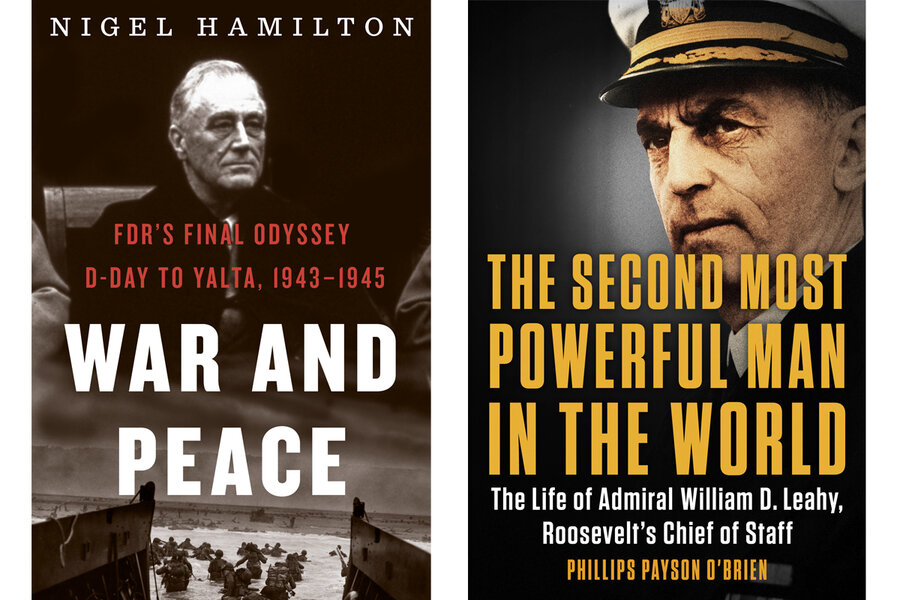President Franklin Roosevelt’s final task: ending World War II
Loading...
Nigel Hamilton completes his epic trilogy on President Franklin Delano Roosevelt’s leadership during the Second World War with “War and Peace: FDR’s Final Odyssey, D-Day to Yalta, 1943-1945,” a grand, poignant, and immensely readable book, even though the story it tells is famously tragic.
The greatest burdens of the war fell on FDR when he was least able to bear them. The final stage of his life was plagued with poor health, and in the course of the mere two years Hamilton chronicles in this volume, everybody who dealt with Roosevelt in person was shocked by how suddenly he seemed to be old and frail. People confided in their correspondence and diaries that the president often seemed not only debilitated but mentally absent. Hamilton includes many of these asides and could have included many more, and the composite impression is one of a man straining to complete his life’s great task before darkness closes in.
That task was, of course, winning the war, and Hamilton makes it clear that the biggest obstacle was often not the Axis powers but Winston Churchill, who did his best to stall and divert Operation Overlord, the code name for the invasion of Normandy, in favor of cockamamie projects in the Aegean or even the Balkans. FDR eventually had to cable him simply “OVERLORD is paramount,” but as Hamilton writes, “To any normal person, the President’s response would have closed the matter. Churchill, however, was no ordinary mortal.”
Hamilton’s account follows Roosevelt from his careful shepherding of Overlord to his July 1944 trip to Hawaii in order to mediate strategy between his two formidable commanders, Admiral Chester Nimitz and General Douglas MacArthur (MacArthur was so struck by FDR’s haggard appearance that he confided to his personal physician, “Doc, the mark of death is upon him! In six months he’ll be in his grave”). Admiral William Leahy, FDR’s omnipresent and immensely powerful chief of staff, considered the Hawaii meeting to be one of Roosevelt’s finest hours as a dominant but persuasive commander in chief. “Certainly in the history of the war on the Allied side,” Hamilton writes, “there had never been anything like it.”
Even in the midst of such triumphs, decline was everywhere and unmistakable. Hamilton’s account of FDR getting through the historic Yalta conference on nothing more than naked determination makes for moving reading, but certainly our author is right to maintain that the pathos of that final decline, recounted in detail in solid books like Joseph Lelyveld’s “His Final Battle” or David Woolner’s “The Last 100 Days: FDR at War and at Peace,” can pull attention away from the larger picture. Hamilton himself, drawing on an impressive array of primary and secondary sources, has successfully broadened the picture. This is not another “final days” account of FDR; rather, it’s a far impressive tale of a long final battle.
One of the most reliable of those primary sources was the aforementioned Admiral Leahy, a flinty, no-nonsense, lifelong Navy man who accompanied FDR everywhere, enjoyed his complete trust, wrote a great many of the cables and memoranda that bore the president’s signature, and did more than any other single person to shape the American military response to World War II.
Leahy kept a meticulous diary and also wrote an invaluable memoir (with the typically gruff title “I Was There”), and now, thanks to historian Phillips Payson O’Brien, he at last has the first-rate biography he’s always deserved. “That he is hardly known today says both a great deal about him and about how he accumulated power,” O’Brien writes in “The Second Most Powerful Man in the World: The Life of Admiral William D. Leahy, Roosevelt’s Chief of Staff.” “We often confuse celebrity with authority.”
When President William Howard Taft remarked of the young naval aide who accompanied him during a West Coast inspection “He’ll ascend to great heights,” he could not have guessed just how far this most famous son of Hampton, Iowa would climb, and O’Brien recounts that astounding career in fascinating detail. “War and Peace” and “The Second Most Powerful Man in the World” unintentionally make almost necessary bookends, in fact: Leahy rose through Roosevelt’s trust and admiration, and Roosevelt’s wartime leadership depended almost entirely on this quiet commander in the background of every photo.








